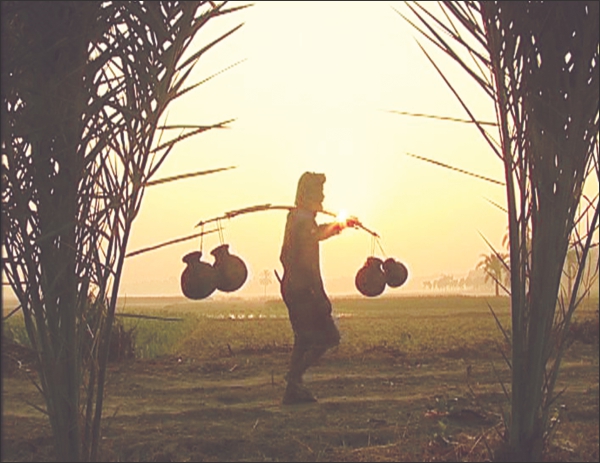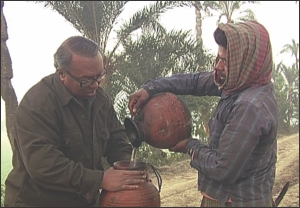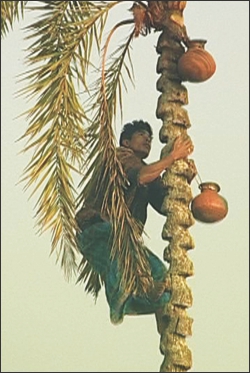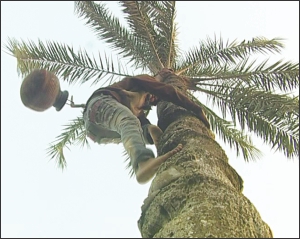Farmers’s Voice
Climbing Up and Down
During a wintry morning of the Bengal, at the early dawn, the gachchis (date juice extractors) are heading to the date trees in Jessore's Bagharpara. This is the ancient image of Bengal. In time's course, many heritages became extinct, but there are some which are still alive. Everything here in the village Borokhudra is in rhythm with the nature. I, the new gachchi joined them few days back and wasn't it so wonderful that took me back to my childhood days…to my memories.
.................................................................................................
Shykh Seraj

Bangladesh has six seasons, but it is pretty difficult now to find their unique attributes. Still, there are some season indicators in the rural parts of Bangladesh. In the villages, the seasons change the way it should. As soon as the winter steps in, it's all about sweet date juice and gur (molasses). To spread out this sweet aura, a group of people are working hard- they are the 'Gachchi' (date juice extractor).
 When people are on their cozy beds in the early dawn of winter, gachchis become busy since then. They also become a part of the nature. When people are on their cozy beds in the early dawn of winter, gachchis become busy since then. They also become a part of the nature.
Gachchis are busy in the entire region. Borokhudra is very famous for producing date juice and gur. The British rulers forced farmers to plant indigo, but as a protest, they planted date seeds so that the British can never grow indigo.
Not only in the villages of Jessore, Jhenaidah, Chuadanga, Kushtia, Meherpur districts, you will see gachchis climbing up the date trees during the winter mornings, but Jessore is way ahead than others. The gachchis from this region are more adept and efficient in this work. They extract date juice in their own way.
 “You're the owner of the date trees”, I asked a gachchi. “You're the owner of the date trees”, I asked a gachchi.
“No, I just work on the trees and share the juice, fifty-fifty with the owner”, replied the gachchi.
“Do you face any problems during work”, I asked.
“Yes, it's really tough to climb up the tree in the early morning”, he replied.
Natural 'Dalua' sugar, made from date molasses and juice has the long heritage of 500 years in this region. In more than hundreds of factories, sugar used to be produced, but not anymore. Now the juice only produces molasses/jaggery (gur).
These images reminded me of the great short-story, 'Rosh' (juice), written by the great litterateur, Nirendranath Mitra. In that story, life of a gachchi has been depicted from every angle. Based on that story, later, Bollywood director, Shudhenda Ray made the feature film, 'Saudagar' (The Merchant) in 1973. Amitabh Bachchan played the lead role of gachchi and his co-artist and lead actress was Notun.
 As I was saying Jessore's date juice and the molasses are famous, they are not much produced now-a-days. They can make only 8 kilos of molasses from 100 litres of date juice. Farmers earn 2,500 taka per maund of gur. Good news is that they don't use any hydros while they make the jaggery. As I was saying Jessore's date juice and the molasses are famous, they are not much produced now-a-days. They can make only 8 kilos of molasses from 100 litres of date juice. Farmers earn 2,500 taka per maund of gur. Good news is that they don't use any hydros while they make the jaggery.
I tasted the date juice- readers, will you taste a bit?
To produce molasses from the date juice is the predominant economic and production resource for the farmers in the region and now marginal gachchis (date juice extractors) have got involved with the trade. However, date trees are becoming extinct in many ways.
I talked with Mr. Shamsur Rahman, a local young man who is much aware of the situation the farmers are dealing with said that date-woods are used at the brick fields regularly and that's why date trees are becoming extinct.
Gachchis (date juice extractors) collect juice at the dawn, then they make the molasses and by noon they have to sell. Afterwards, they have to prepare the trees for next day extraction. Bengali heritages are filled in every phases of these activities.
Dear readers, I went straight back to the childhood days and hope so did you and it's nice to believe that still we have our own heritages of which we are really proud. I firmly believe that government will look after these people who are climbing up and down forever.
Photographs by Srabon Reza

Copyright
(R) thedailystar.net 2013 |


 When people are on their cozy beds in the early dawn of winter, gachchis become busy since then. They also become a part of the nature.
When people are on their cozy beds in the early dawn of winter, gachchis become busy since then. They also become a part of the nature.  “You're the owner of the date trees”, I asked a gachchi.
“You're the owner of the date trees”, I asked a gachchi.  As I was saying Jessore's date juice and the molasses are famous, they are not much produced now-a-days. They can make only 8 kilos of molasses from 100 litres of date juice. Farmers earn 2,500 taka per maund of gur. Good news is that they don't use any hydros while they make the jaggery.
As I was saying Jessore's date juice and the molasses are famous, they are not much produced now-a-days. They can make only 8 kilos of molasses from 100 litres of date juice. Farmers earn 2,500 taka per maund of gur. Good news is that they don't use any hydros while they make the jaggery. 